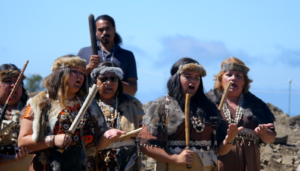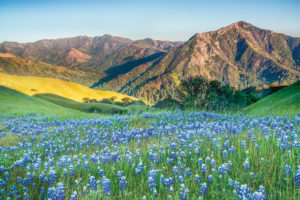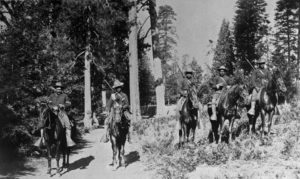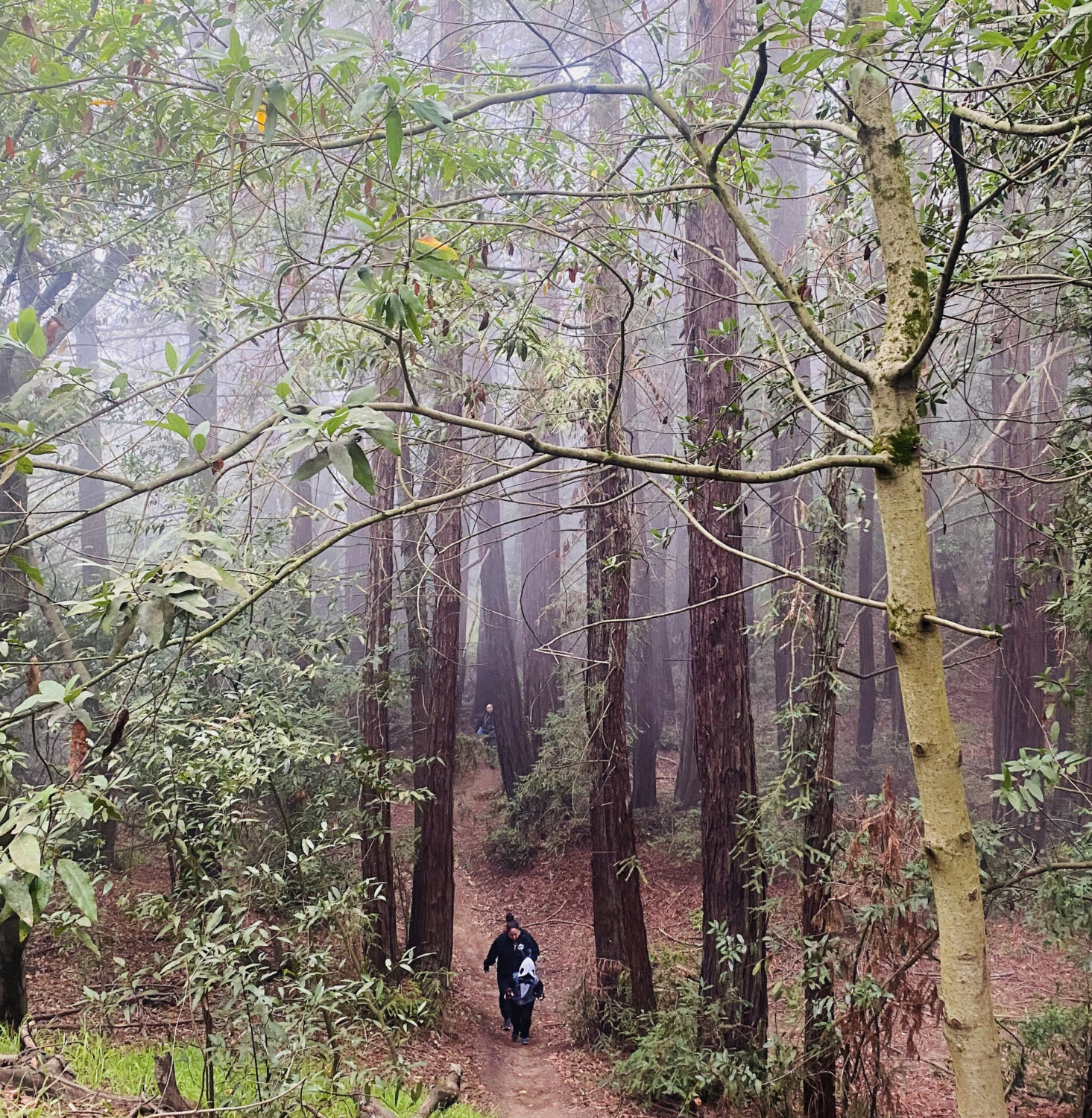
This piece was produced in collaboration with News from Native California, a nonprofit quarterly magazine devoted to the vibrant cultures, arts, languages, histories, social justice movements, and stories of California’s diverse Indian peoples.
On the surface, Sequoia Point seems like another lovely spot in a Bay Area park, with gnarled oaks, towering old-growth redwoods and a glorious view of the Bay. But this scenic overlook in Oakland’s Joaquin Miller Park has now acquired new significance, and a new Chochenyo name—Rinihmu Pulte’irekne, meaning “Above the Red Ochre”—because the city government has voluntarily returned it to Indigenous hands.
Like many Indigenous groups in the Bay Area and along the California coast, the Confederated Villages of Lisjan is not a federally recognized tribe, which makes it incredibly difficult to reclaim land. Oakland has become the first city in the Bay Area to return public land to a tribal entity without that recognition. The city created a cultural conservation easement that gives the Indigenous-led Sogorea Te’ Land Trust stewardship over the land in perpetuity.
It’s a blueprint that other cities could follow to return public land to Indigenous communities, according to Corrina Gould, Lisjan tribal chair and co-founder of the land trust, a nonprofit conservation organization. The trust represents Ohlone and urban Indigenous people from various tribes living in the East Bay.
“This little piece of five acres is going to do a lot to change the landscape of Oakland,” Gould says.

The land formerly known as Sequoia Point did not change hands overnight. The successful return of these five acres to Indigenous stewardship was preceded by years of protests, legal strategizing, fundraising, and hundreds of miles of prayer walks around San Francisco Bay. Yet in the end, the conservation easement was freely offered by Oakland and unanimously approved by the city council.
“It’s an act of the people of Oakland, so to speak, returning this land to Indigenous stewardship,” says Darin Ranelletti, Oakland’s housing security policy director.
The city of Oakland remains the official property owner. The public will continue to have access, but the Sogorea Te’ Land Trust will be able to close the site for habitat restoration projects and private events such as ceremonies.
The trust was founded in 2015 by Gould and Johnella LaRose, a Shoshone-Bannock of the northern Great Basin. Since then, the trust has been acquiring land for urban Indigenous people piece by piece—places to hold naming ceremonies, grow native foods, and someday create a place to bring ancestral remains to rest. So far, Sogorea Te’ has secured access to a variety of sites through long-term leases and collaborations, such as a small garden in West Oakland, a quarter-acre ceremonial space in East Oakland, and a portion of ‘Ookwe Park in Richmond; the trust also owns a house in Oakland.
At Rinihmu Pulte’irekne, the trust plans to hold ceremonies, restore native plants, and create space for education and outreach. The new name’s meaning “above the red ochre” refers to the Oakland hills’ past as a source of ochre pigment for Ohlone people.
Why Indigenous land claims are so rare
The loss of Ohlone land in the Bay Area came in three waves of colonization and genocide, beginning with the Spanish in the 18th century and followed by Mexican and American regimes.
“Each one of those waves of colonization involved some seizure of land and violence toward native people,” says Beth Rose Middleton Manning, a Native American studies professor at UC Davis.
“Ohlone” is an umbrella term for around 50 Indigenous tribes, speaking related languages and living in coastal California from San Francisco and the Carquinez Strait south to Monterey Bay. It includes people speaking languages such as the Ramaytush on the peninsula, Karkin along the Carquinez Strait, Chochenyo in the East Bay, and Tamien, Awaswas, Mutsun, Rumsen, and Chalon in the south toward Big Sur.
Spanish missionaries took Ohlone people away from their traditional homelands and into mission labor camps, forcibly converting them to Catholicism. Mexico, after its war of independence, granted swaths of Ohlone territory to soldiers—hence place names such as San Leandro, San Antonio, San Pablo. Americans enslaved and attempted to exterminate the remaining Indigenous people, with the California legislature paying white settlers $5 a head and 25 cents an ear. This history of slaughter and displacement helps explain why it is rare for Indigenous peoples in the Bay Area to claim specific lands, and even rarer for them to get land back.
The most common way for tribes to acquire land is through federal recognition, a status that acknowledges a tribe as sovereign. The federal government is obliged to provide recognized tribes health and education resources, and hold lands in trust for them as tribal reservations. But applying for federal recognition requires land claim documentation that has often been destroyed during colonization.
California has the greatest number of unrecognized tribes of any state in the U.S. Congress never ratified 18 treaties made with California tribes, and in the 1950s Congress terminated tribal recognition for 41 California tribes, making it extraordinarily difficult for many of them to meet recognition criteria today. The state is home to 80,000 people from unrecognized tribes. In order to hold land, such tribes must form some kind of legal entity, such as a nonprofit or land trust.
There are no federally recognized tribes along the California coast from around the Golden Gate to the Chumash reservation in Santa Barbara. “But there are a lot of Indigenous tribes and Indigenous people, and they want to protect their cultural places, just like the recognized ones do,” says Michelle LaPena, a tribal law attorney and member of the Pitt River tribe in northeastern California. LaPena helped negotiate the cultural conservation easement on behalf of the Sogorea Te’ Land Trust.

How a land trust was born
Years ago, Gould and LaRose set their sights not on federal recognition, but on the land itself.
In 2005, Gould and LaRose’s first group, Indian People Organizing for Change, organized annual Bay Area shellmound prayer walks to draw attention to the significance and desecration of Ohlone shellmounds. Ohlone tribal members and allies walked for about 300 miles over the course of three weeks each fall for three years. The route stopped at dozens of ancestral burial and village sites from Vallejo to San Jose and up the Peninsula to San Francisco. Nearly all of the sites had been paved over with concrete, under shopping malls like Bay Street Emeryville, condos and parking lots.
In April 2011, one of those sacred sites came under further threat of desecration. A 3,500-year-old Karkin Ohlone village site called Sogorea Te’, where Ohlone people had made a last stand before being kidnapped by missionaries, had become a park in Vallejo. The Greater Vallejo Recreation District was planning to bulldoze parts of the site, including former shellmounds that might contain human remains, for a new parking lot and other development.
“We all decided that we should go up and take it over in a prayerful way,” says Gould.
Nearly a hundred tribal members and others gathered at Sogorea Te’ and camped there in protest. They lit a ceremonial fire, and kept it going for 109 days. People from various tribes and Indigenous heritages came. They sang, told stories, danced, prayed, and in July, they won––or so it seemed. A nearby federally recognized tribe agreed to sign a cultural easement on behalf of the Ohlone, and the city of Vallejo promised to protect the site from development. The fire was put out, and the camp disbanded.
But the very next year, the parking lot was built anyway. Despite the loss, Gould views the events at Sogorea Te’ as a spiritual victory that brought the Ohlone who stood up for the site together and cemented their sense of purpose. “This land brought us all together for a reason,” Gould said in Beyond Recognition, a documentary about the events leading up to the formation of the Sogorea Te’ Land Trust.
Shortly after the Sogorea Te’ encampment disbanded, Gould learned of a different tool: nonprofit organizations known as land trusts, which have long been used for environmental conservation. But in recent years, California tribes have begun using them for land reclamation —such as the Amah Mutsun Land Trust south of the Bay and the Tongva Taraxat Paxaavxa Land Conservancy in Southern California.
In 2015, Gould and LaRose formed the Sogorea Te’ Land Trust with the goal of reclaiming land for Indigenous people in the East Bay bit by bit. Gould dreams of acquiring the land needed to rebury her people’s ancestors and rematriate the remains from institutions like UC Berkeley’s Hearst Museum of Anthropology. The museum holds thousands of Ohlone remains unearthed from Bay Area shellmounds, as well as remains from other Bay Area tribes.
“We have been praying for years for our ancestors to come home from these institutions, but we knew we didn’t have anywhere to put them,” says Gould. “So a land trust made sense.”
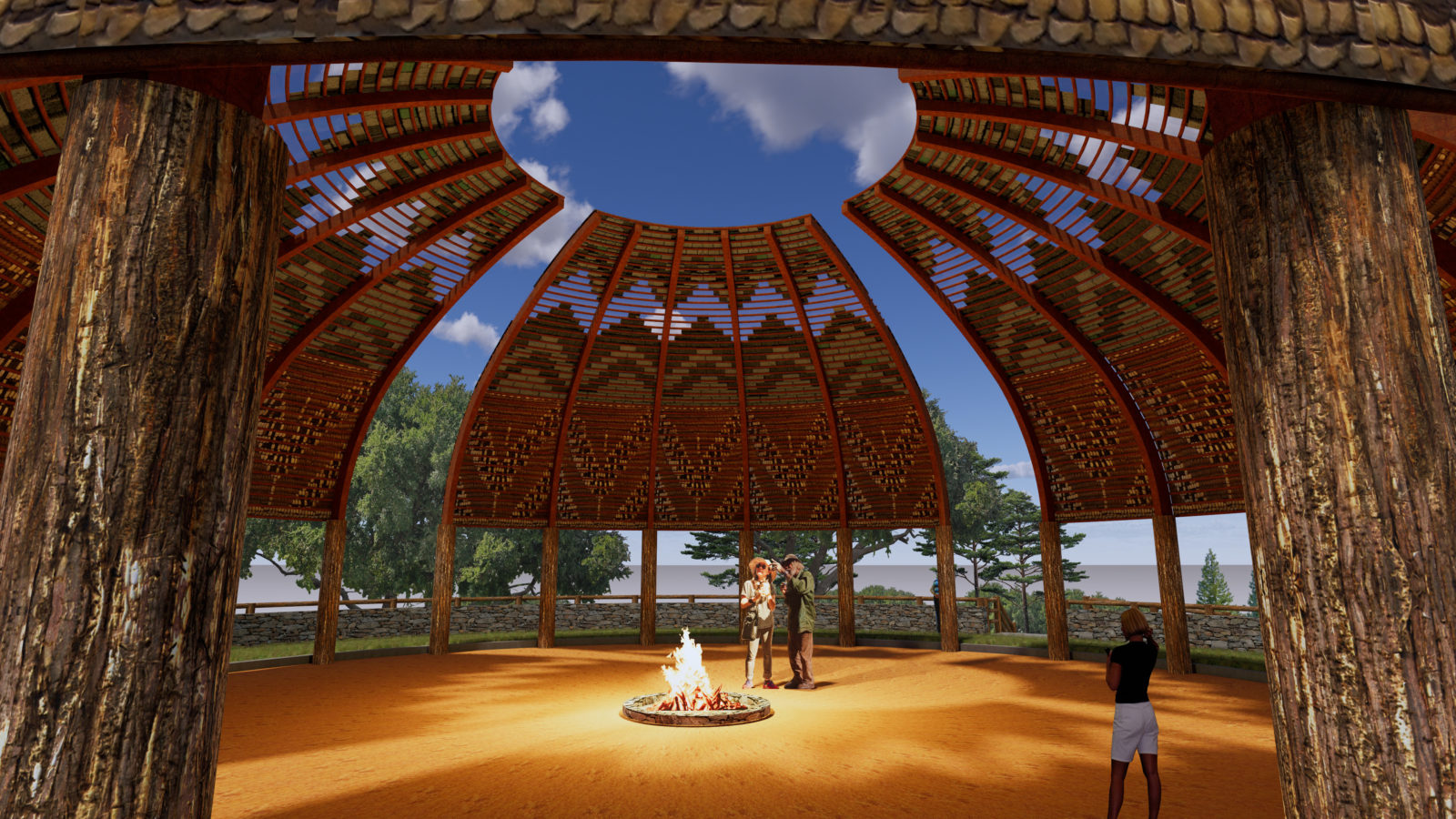
A new kind of land back
In 2017, Oakland Mayor Libby Schaaf saw the documentary about the Sogorea Te’ Land Trust and was moved. She reached out to the trust, wanting to contribute to their cause by finding a way to give back public land in Oakland. Mayor Schaaf invited the land trust to choose a site in Joaquin Miller Park, and two young tribal members chose Sequoia Point, for its accessibility and expansive view of ancestral Ohlone lands.
For Gould, creating a legal blueprint that other cities could follow to return lands to non-federally recognized tribes was a priority. Using a conservation easement for cultural preservation only requires approval from the city council, with no need for federal recognition or approval from any other government body. As a uniquely straightforward approach to restore land rights to Indigenous groups, cultural conservation easements could be used by local governments elsewhere in the Bay Area and beyond.
“We’re hopeful that it will inspire other cities, and that we could also do this potentially at other locations around Oakland,” says Ranelletti, the city’s housing policy director. “We’re just getting started.”
The cultural conservation easement conveys all land ownership rights to the Sogorea Te’ Land Trust. Any construction will require a permit, rezoning and an environmental review. The city also reserves the right to access the site in an emergency, like a wildfire. The easement cannot be undone by any future mayor or city council without an agreement from both parties or an act from a court.
Gould and other tribal members dream of building a structure resembling an upside-down traditional Ohlone basket at Rinihmu Pulte’irekne. In an architectural rendition of the structure, the overturned basket stands on pillars over a central fire pit, with yellow and black lines zigzagging against brown and white stripes. It would provide a shelter where people could gather for prayers, ceremonies and celebrations. The basket represents coming home, Gould says. A heritage that holds the community together, a place to remember ancestors and future generations. A basket of dreams, inspired by the land.

